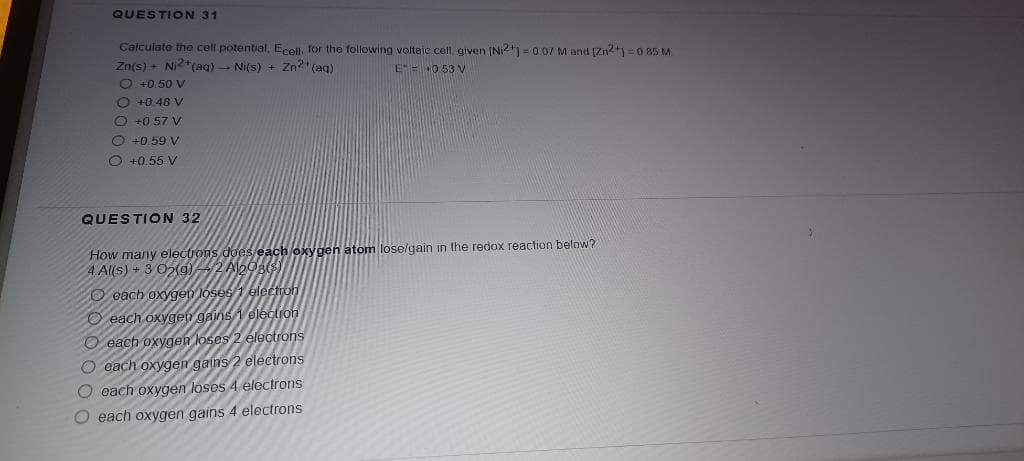Calculate the cell potential, Ecell, for the following voltaic cell, given (N2+=0.07 M and (Zn2+) = Zn(s) + Ni2*(aq)- Ni(s) + Zn? (aq) O +0.50 V 330 85 M E=053 V +0 48 V O +0 57 V +0.59 V O +0.55 V QUESTION 32 How many electons does each oxygen atom lose/gain in the redox reaction below? 4 Al(s) + 3 02(g)2Abos) O each oxygen loses 1 blectron O each oxygen dains 1 electron O each oxygen loses 2 électrons each oxygen gains 2 electrons O each oxygen loses 4 electrons each oxygen gains 4 electrons
Calculate the cell potential, Ecell, for the following voltaic cell, given (N2+=0.07 M and (Zn2+) = Zn(s) + Ni2*(aq)- Ni(s) + Zn? (aq) O +0.50 V 330 85 M E=053 V +0 48 V O +0 57 V +0.59 V O +0.55 V QUESTION 32 How many electons does each oxygen atom lose/gain in the redox reaction below? 4 Al(s) + 3 02(g)2Abos) O each oxygen loses 1 blectron O each oxygen dains 1 electron O each oxygen loses 2 électrons each oxygen gains 2 electrons O each oxygen loses 4 electrons each oxygen gains 4 electrons
Chemistry: An Atoms First Approach
2nd Edition
ISBN:9781305079243
Author:Steven S. Zumdahl, Susan A. Zumdahl
Publisher:Steven S. Zumdahl, Susan A. Zumdahl
Chapter17: Electrochemistry
Section: Chapter Questions
Problem 69E: Consider the concentration cell shown below. Calculate the cell potential at 25C when the...
Related questions
Question

Transcribed Image Text:QUESTION 31
Caiculate the cell potential, Ecell, for the following voltaic cell, given IN2+ = 0.07 M and [Zn2+j = 0 85 M
Zn(s) + Ni2*(aq) - Ni(s) + Zn? (ag)
O +0.50 V
E= 0 53 V
O +0 48 V
O +0 57 V
O +0.59 V
O +0.55 V
QUESTION 32
How many electons does each oxygen atom loselgain in the redox reaction below?
4 Al(s) + 3 O2(g)2 Al208($)
O each oxygen loses 1 électrof
O each oxygen gains 1 electron
O each oxygen loses 2 électrons
O each oxygen gains 2 electrons
O each oxygen loses 4 electrons
O each oxygen gains 4 electrons
Expert Solution
This question has been solved!
Explore an expertly crafted, step-by-step solution for a thorough understanding of key concepts.
Step by step
Solved in 6 steps with 3 images

Knowledge Booster
Learn more about
Need a deep-dive on the concept behind this application? Look no further. Learn more about this topic, chemistry and related others by exploring similar questions and additional content below.Recommended textbooks for you

Chemistry: An Atoms First Approach
Chemistry
ISBN:
9781305079243
Author:
Steven S. Zumdahl, Susan A. Zumdahl
Publisher:
Cengage Learning


Chemistry
Chemistry
ISBN:
9781305957404
Author:
Steven S. Zumdahl, Susan A. Zumdahl, Donald J. DeCoste
Publisher:
Cengage Learning

Chemistry: An Atoms First Approach
Chemistry
ISBN:
9781305079243
Author:
Steven S. Zumdahl, Susan A. Zumdahl
Publisher:
Cengage Learning


Chemistry
Chemistry
ISBN:
9781305957404
Author:
Steven S. Zumdahl, Susan A. Zumdahl, Donald J. DeCoste
Publisher:
Cengage Learning


Principles of Instrumental Analysis
Chemistry
ISBN:
9781305577213
Author:
Douglas A. Skoog, F. James Holler, Stanley R. Crouch
Publisher:
Cengage Learning